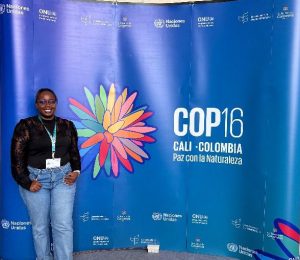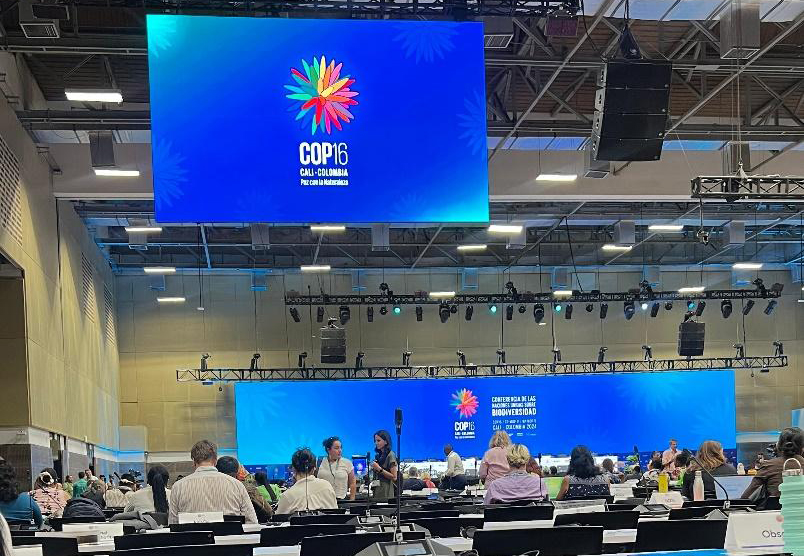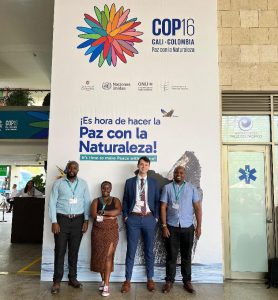As I embarked on the 24-hour journey from Kenya to Cali, Colombia, for the UN Biodiversity Conference (CBD COP16), I felt a mix of excitement and anxiety. It was my first experience at such a massive global event, and I was worried I would get lost in the whirlwind of activity and importance surrounding the conference.

Yet, as I entered the bustling Centro de Eventos Valle del Pacifico, those nerves quickly turned to awe — I realized I was part of a global movement pushing for change. It was a moment I won’t soon forget.
Before coming to COP16, my experience with global negotiations had been mostly from an academic standpoint: Twenty-fifth meeting of the Subsidiary Body on Scientific, Technical and Technological Advice (SBSTTA25), and capacity-building efforts with the African Youth for Biosciences Network (AYBN)-ISAAA AfriCenter. COP16 is the first Biodiversity COP since the adoption of the 2022 Global Biodiversity Framework.
This year’s conference was crucial as governments reviewed their National Biodiversity Strategies and Action Plans (NBSAPs) to align with this framework. I was particularly interested in how synthetic biology and Access and Benefit Sharing (ABS) mechanisms for digital sequence information (DSI) would be implemented—key topics falling under targets 13 (Increase the Sharing of Benefits From Genetic Resources, Digital Sequence Information and Traditional Knowledge) and 17 (Strengthen Biosafety and Distribute the Benefits of Biotechnology) of the framework.
As I was planning for COP16 one advice that I was given and that I would give to any person planning to attend CBD COP is to know what you want to learn- familiarize self with the CBD website- including how to navigate it, and learn the terminologies used there. With this advice in mind, I selected the first contact group that I would attend, the Contact Group (WG-II) on Synthetic Biology.
 As I attended the Synthetic Biology Contact Group sessions, I saw how the rapid evolution of biotechnology since the early CBD negotiations in the 1990s has brought new challenges. Today, digital sequence information is used in artificial intelligence to design new organisms and proteins, while engineered viruses and gene drives are created to propagate autonomously in nature. Discussions highlighted two key issues for review: the need for a regular horizon scanning process and capacity building with dedicated funding.
As I attended the Synthetic Biology Contact Group sessions, I saw how the rapid evolution of biotechnology since the early CBD negotiations in the 1990s has brought new challenges. Today, digital sequence information is used in artificial intelligence to design new organisms and proteins, while engineered viruses and gene drives are created to propagate autonomously in nature. Discussions highlighted two key issues for review: the need for a regular horizon scanning process and capacity building with dedicated funding.
Africa’s stance was clear—prioritizing capacity building in synthetic biology, including a focused action plan for knowledge transfer, over the broad and continuous horizon scanning, which they felt could duplicate efforts and strain resources. Concerns arose around redundancy, particularly since the Cartagena Protocol already addresses Living Modified Organisms (LMOs), and synthetic biology is currently outside the Kunming-Montreal Global Biodiversity Framework (KMGBF).
However, some parties felt that placing synthetic biology under the Cartagena Protocol would create more regulatory hurdles since not all synthetic biology products are genetically modified.
As we look forward to the last week of COP16, we hope that negotiations will yield fruits and that a clear road map will be developed to inform the role of synthetic biology in implementing and achieving the KMGBF goals.
The next session I selected was Contact Group (WG-I) on DSI. The negotiation on digital sequence information was more complex and heated as it proved to have more discourse amongst parties. Establishing a multilateral benefit-sharing mechanism for DSI has proved contentious, as it would disrupt the currently unregulated landscape where DSI is readily accessible online without accountability to the communities holding traditional rights. Without proper records of a sequence’s origin, users are under no obligation to share benefits.
At COP16, some parties advocated for non-commercial users to contribute non-monetary benefits by depositing sequences in open-source databases while using the Global Fund to support capacity-building in underrepresented regions. They also proposed that commercial entities contribute a portion of profits to the Global Fund, which could capture benefits from unpredictable future applications of DSI, including Artificial Intelligence (AI).
However, these positions clashed with those of developing countries, especially the African Group, which urged for a centralized, legally binding DSI database under the CBD to protect community rights. As square brackets continued to mark unresolved points in the negotiation texts, it became clear that significant work remained to finalize this agenda item within the week.

During the first week, COP16 opened all agenda items, formed 16 contact groups, and produced 24 conference room papers. The conference offered fascinating insight into the emerging technologies that will shape our future, and I had the chance to engage directly with the scientific minds driving these innovations. Yet, I also noticed a gap in youth representation—while platforms for discussion existed, equitable opportunities to contribute were not always present, leaving me to wonder how future COPs can make dialogue more inclusive.
Leaving COP16, I carry a renewed sense of purpose and invaluable knowledge to share with other youth. The road ahead is long, but if there is one thing I learned in Cali, it is that change is possible when we come together. I hope in the coming years, more voices will join the movement and be part of the plan for a sustainable, fair, and hopeful future.
Stay tuned for an update on the final decisions made during CBD COP16!
By Ednah Wanjiru, Program Officer, Open Forum on Agricultural Biotechnology in Africa (OFAB)-Kenya Chapter. You can reach her at emacharia@isaaa.org.